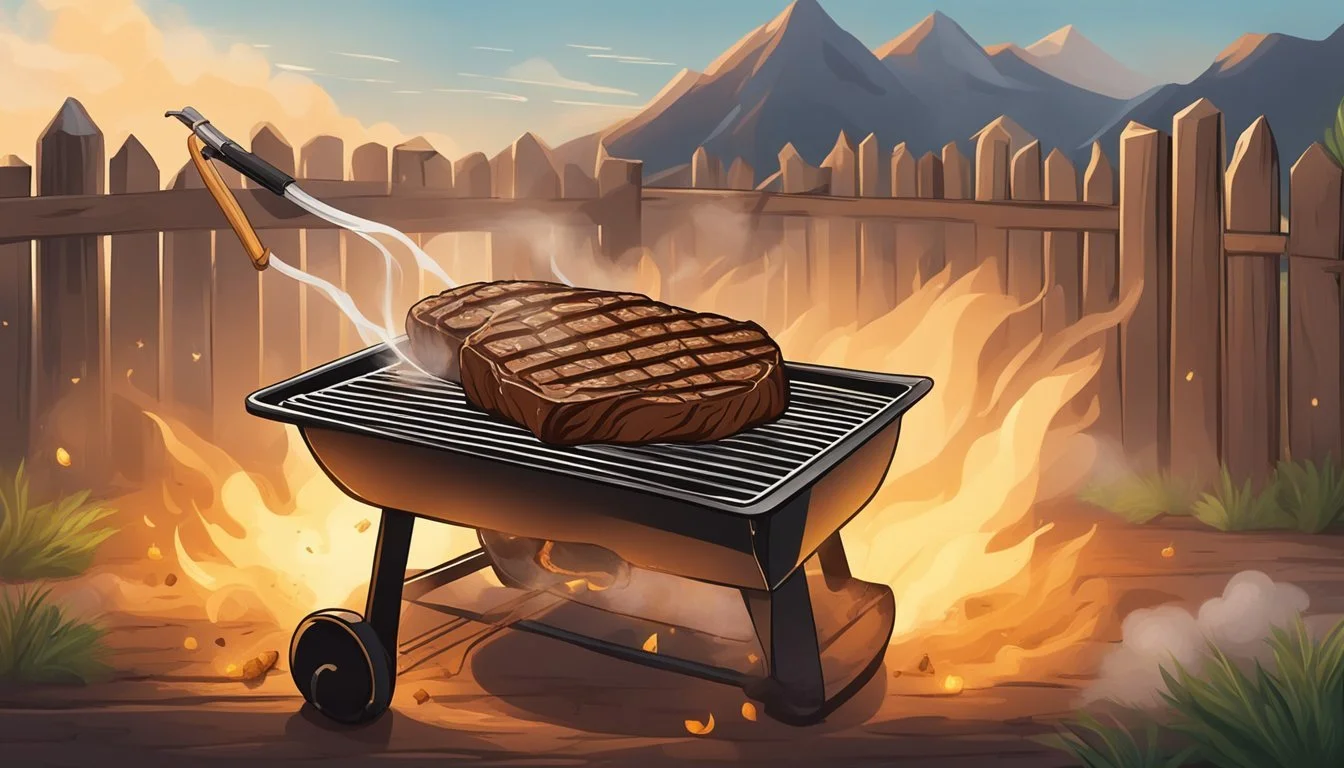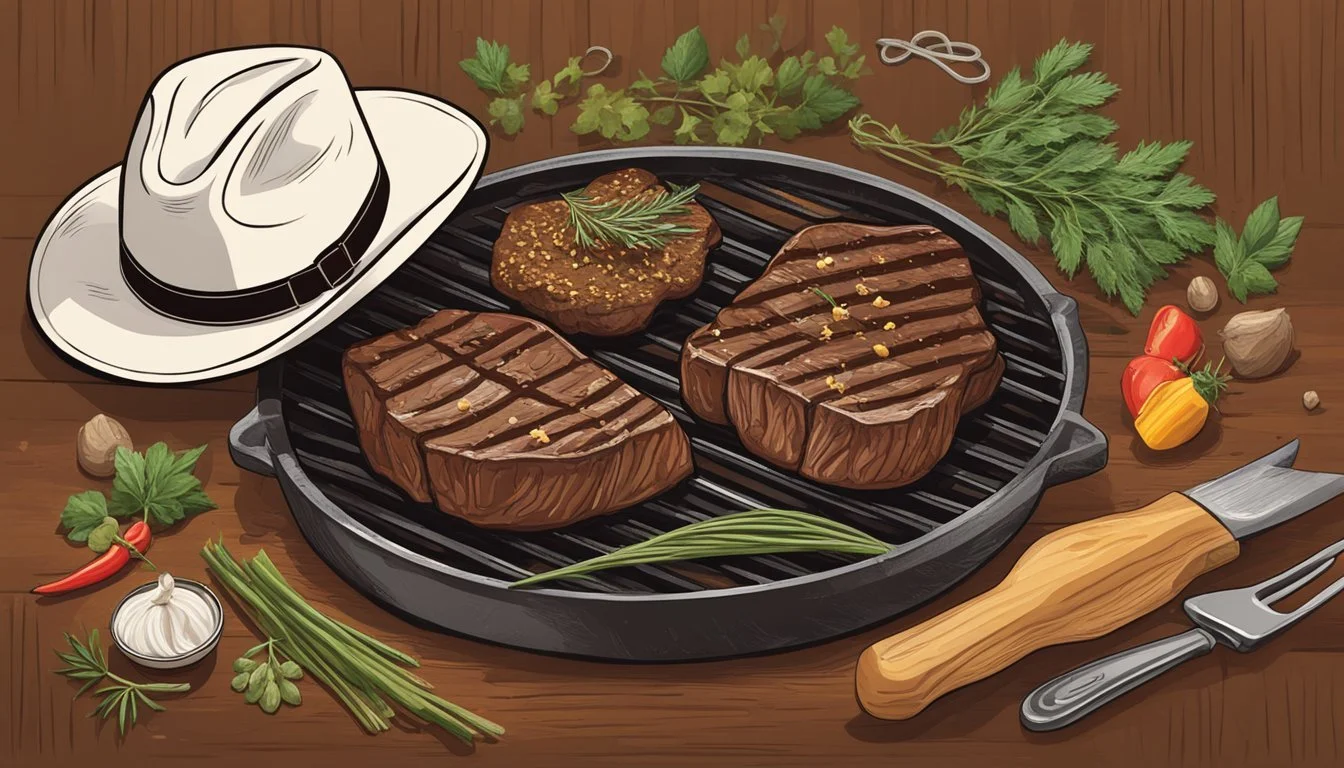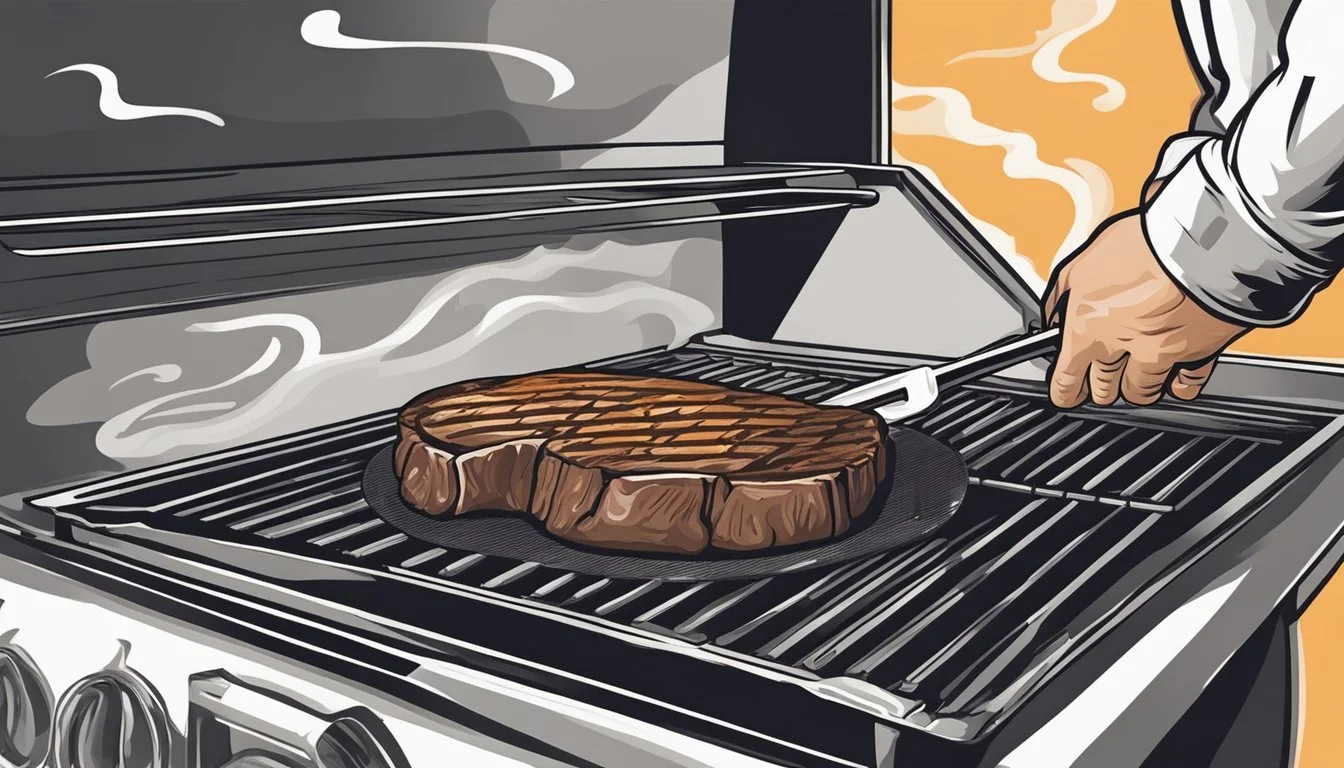The Texas Cowboy's Guide to the Perfect Steak
Mastering the Art of Grilling
The quintessential Texas cowboy is renowned for an unrivaled expertise in crafting a steak that boasts the perfect balance of flavor and tenderness. Such mastery over the art of steak preparation is rooted in tradition, where meticulous attention to detail and precise cooking techniques are paramount. The journey to the perfect steak begins long before it reaches the flame, with careful selection and preparation setting the stage for culinary excellence.
Steak cooking in Texas transcends mere sustenance, embodying a cultural ritual that pays homage to the simplicity and robustness of cowboy cuisine. Understanding the importance of temperature control, seasoning, and timing is essential. Whether it's a thick-cut cowboy bone-in ribeye or any other premium cut, the methods employed by the Texas cowboy ensure that the natural flavors of the meat are accentuated, while the texture achieves that ideal succulence sought after by steak aficionados.
The temperature of the steak prior to grilling, the preheating of the grill, and consistent flipping are just a few of the elements that play a critical role in the process. With each carefully executed step, the steak is coaxed closer to perfection. Following these guidelines ensures a steak that's not only a tribute to the cowboy way but also a culinary experience that's deeply rooted in the heart of Texas traditions.
Choosing the Right Cut
Selecting the perfect steak begins with understanding what makes beef high-quality and distinguishing between various types of cuts. The perfect thickness can elevate the flavor and texture, resulting in a memorable eating experience.
Identifying Quality Beef
When examining beef at the meat counter, one should look for a piece with good marbling — the white flecks of fat within the muscle that ensure succulence and flavor. Beef grading is also an indicator of quality, with USDA Prime being the highest, indicating abundant marbling, followed by USDA Choice and Select.
Differentiating Steak Types
Various cuts of steak offer different flavors and textures. A cowboy steak, a thick-cut bone-in ribeye, presents a generous amount of meat seasoned with the rich flavor from the bone. The tomahawk steak, an impressive version of the cowboy steak, features a long bone extending from the meat, adding to its presentation. On the other end of the spectrum, a beef tenderloin (What wine goes well with beef tenderloin?) is lean yet tender, without the bone influence but can be less flavorful than well-marbled cuts.
Selecting the Perfect Thickness
Thickness plays a crucial role in the cooking process. Thick-cut ribeyes like the cowboy or tomahawk steak should be at least 1.5 inches thick to ensure they can develop a rich crust while maintaining a juicy interior when grilled. A bone-in steak's thickness ensures even cooking and retains the natural juices. One should avoid steaks that are too thin as they are prone to overcooking and drying out.
Preparation Fundamentals
The path to a flawless steak begins with two pivotal steps: allowing the meat to reach ambient temperature and an adept application of seasoning.
Bringing Meat to Room Temperature
Ensuring that the steak reaches room temperature is vital. One should remove the steak from the refrigerator approximately 45 minutes before cooking. This procedure equalizes the steak's temperature throughout, promoting even cooking and a juicier result.
Seasoning Techniques
Seasoning is not a step to be taken lightly; it lays the foundation for a steak's flavor profile. High-quality kosher salt or sea salt and freshly ground black pepper should be used liberally to form a flavorful crust. For a thick steak, ample seasoning is necessary as it must penetrate and flavor the entire cut. Applying salt and pepper should occur roughly 20 minutes before cooking, giving time for the seasoning to adhere properly.
To enhance the flavors further, one can lightly coat the steak with a high-smoke point oil such as olive oil, complementing the natural flavors rather than overpowering them. After seasoning, the steak should be left to rest, allowing the salt to draw out moisture, which then gets reabsorbed, distributing the seasoning internally.
Remember, a perfectly seasoned steak requires a bold and even application of both salt and pepper, which acts as the foundation for the ultimate Texas Cowboy steak experience.
Mastering the Grill
When preparing a steak, the grill's mastery is pivotal in achieving a flavorful and perfectly cooked meal. The subtleties of grilling methods, heat management, and searing techniques are the cornerstones of a delectable steak experience.
Grilling Methods
Indirect Heat: For thicker cuts like a prime rib, they should start with indirect heat on a charcoal grill. The steak is placed on the cooler side, away from the coals, allowing it to cook slowly, which is essential for maintaining its juiciness and tenderness.
Reverse Sear: Reverse searing involves cooking the steak on indirect heat first and then finishing it off with a direct, high heat sear. This method is highly effective for thick-cut steaks, developing an even internal temperature and a desirable crust.
Managing Heat Levels
One must be adept at managing the grill's temperature to serve the perfect steak. It involves a two-zone fire setup for versatility:
Medium-High Heat: The hotter zone targets medium-high heat, ideal for searing. A temperature range of 375°F to 450°F is optimal for a gas grill.
Charcoal Grill: For charcoal grills, heat levels are controlled by the amount of charcoal and its distribution. The coals should be piled on one side to create direct and indirect zones.
Creating the Perfect Sear
The sear introduces flavor and texture to the steak through caramelization. It requires confident timing and technique:
Preheat the Grill: Ensure the grill grates are hot enough to instantly sizzle upon steak contact.
Dry Surface for Perfect Char: Pat the steak dry before placing it on the grill to aid in achieving that perfect char.
Frequent Flipping: Flip the steak every 15-30 seconds on high heat after the initial indirect cooking, providing an evenly distributed sear.
Grilling a steak is part art, part science, but with these techniques, one can confidently approach the grill to craft a memorable meal.
Cooking to Perfection
Achieving the perfect steak hinges on precision cooking and temperature control. Let's explore how to utilize tools and techniques to ensure every steak reaches its pinnacle of flavor and texture.
Using a Meat Thermometer
To avoid the guesswork in steak doneness, one should always employ a meat thermometer. The ideal types are the instant-read thermometers, which provide quick and accurate readings. For a medium-rare steak, one should aim for an internal temperature of 130°F before removing it from the heat.
Understanding Doneness
Understanding the levels of doneness is essential for tailoring the steak to diners' preferences:
Rare (120-125°F): A warm, red center
Medium-Rare (130-135°F): Warm and mostly pink with a red center, offering a juicy texture
Medium (135-145°F): A hot pink center, slightly less juicy
Medium-Well (145-155°F): Mostly brown with a hint of pink
Well-Done (over 155°F): Brown throughout and firmer to the touch
It's important to note that steaks will continue to cook for a short period after they're removed from the heat, known as "carryover cooking," so it's best to pull the steak off the grill or out of the pan just before it reaches the desired temperature.
Resting the Steak
Rest is not just for the weary but essential for the perfect steak. After reaching the desired internal temperature, the steak should be taken off the heat and allowed to rest for at least 5 to 10 minutes. This allows the juices to redistribute throughout the steak, ensuring that each bite is as flavorful and juicy as the last. To serve, slice against the grain for maximum tenderness.
Enhancing Flavor and Presentation
The perfect steak is a balance of robust flavor and an impressive presentation that tantalizes the taste buds and delights the eyes. Achieving this requires attention to both the finishing culinary touches and thoughtful serving and pairing.
Applying Finishing Touches
Flavor enhancement begins with the basics: salt and pepper. These essentials should be applied generously before cooking to ensure a flavorful crust. A high-smoke-point oil such as vegetable oil is recommended to sear the steak without burning. To inject an additional layer of flavor, a knob of butter, crushed garlic, and fresh herbs like parsley or thyme can be added towards the end of cooking; they should be spooned over the steak to baste it.
For those desiring a unique tang, lemon zest or chimichurri—a zesty herb-based sauce—can be prepared in advance and drizzled over the steak before serving. A proper rest period of five minutes allows the juices to redistribute, ensuring each bite is juicy and flavorful.
Herbs & Condiments Purpose Salt and Pepper Enhance meat flavor, form a crust Butter and Garlic Add richness and aroma during baste Parsley/Herbs Freshness and color Lemon Zest Brightness and acidity Chimichurri Vibrant, herby kick
Serving and Pairing
Once plated, the presentation is pivotal. A clean white plate showcases the steak, which can be pre-sliced against the grain. This not only makes it easier to eat but also displays the perfectly cooked interior. Garnishes such as a sprig of parsley or edible flowers add visual interest.
Side dishes should complement, not compete with the steak. Options like roasted potatoes or grilled asparagus (What wine goes well with grilled asparagus?) are classic, while a light salad can offer a refreshing contrast. Wine, specifically a bold Cabernet Sauvignon, makes an excellent pairing, its tannins melding well with the rich flavors of the steak.
Side Dishes Wine Pairing Roasted Potatoes Cabernet Sauvignon Grilled Asparagus Light Salad
Through these methods, one can ensure that each steak served is not only rich in flavor but also presented with a finesse that enhances the overall dining experience.
Cookware and Tools
When aiming for that perfect steak, the cookware and tools one employs are as crucial as the cut of meat itself. Temperature control, even heating, and a reliable surface for searing are foundational for achieving a medium-rare cast iron cowboy steak.
Essential Steak-Cooking Equipment
To cook a steak worthy of a Texas cowboy, one must have the right equipment on hand. Key items include:
Cast Iron Skillet: Indispensable for high-heat searing and even cooking.
Meat Thermometer: Critical for ensuring the steak reaches the desired medium-rare temperature without overcooking.
Tongs: A pair with a good grip and heat-resistant handle is important for handling the steak.
Cutting Board: Ample size and sturdy material make for easier slicing upon resting.
Resting Rack: Allows air to circulate around the steak, ensuring even cooling and juice retention.
A proper set of tools ensures control over the cooking process, enabling the chef to deftly manage the steak from the initial sear to the final rest.
Choosing a Cast Iron Skillet
When selecting a cast iron skillet, one should consider the following:
Size: A 10-12 inch skillet is versatile, offering ample space for most steaks while maintaining high temperatures.
Weight: Heavier skillets distribute heat more evenly, a key factor for the perfect sear.
Handle: A cast-iron skillet with a comfortable, sturdy handle ensures safer maneuvering.
Heirloom or newly minted, a well-seasoned cast iron skillet is synonymous with classic steak preparation. Pre-heating the skillet is imperative, as it creates the optimal searing surface for locking in those juices and flavors essential to the cast iron cowboy steak experience.
Recipe Collection
In this collection, readers will discover the essence of classic cowboy steak preparations along with innovative approaches to marinades and rubs.
Classic Cowboy Steak Recipes
For a classic cowboy steak, the key lies in selecting a thick steak with rich marbling that promises a tender and juicy experience. Recipes often start with seasoning the steak generously with salt and pepper, allowing it to sit at room temperature for around 30 minutes before cooking.
Cowboy Steak with Ranch Butter:
Preparation: Blend softened butter with ranch seasoning and parsley.
Cooking: Sear the seasoned steaks on high heat and finish on indirect heat.
Traditional Cowboy Ribeye:
Preparation: Season steaks with coarse salt and cracked black pepper.
Cooking: For a medium-rare finish, grill for approximately 4 minutes on each side until the internal temperature reaches 130°F.
Innovative Marinades and Rubs
Expanding on tradition, inventive marinades and rubs can transform a cowboy steak into a special occasion dish.
Cowboy Butter with a Twist:
Ingredients: Mix butter with garlic, mustard, or Worcestershire sauce for a burst of flavor.
Usage: Slather on the steak after cooking for a rich finish.
Ingredients: Combine brown sugar with chili powder and smoked paprika.
Usage: Rub onto the steak to create a caramelized, spicy crust when grilled.
Whether opting for the simplicity of salt and pepper or adding complexity with a bold rub, one should not hesitate to experiment with flavors while respecting the natural savoriness of a high-quality cowboy steak.
Post-Cooking Tips
After expertly cooking a Texas-style steak, one should not overlook the importance of handling leftovers efficiently and exploring alternative cooking methods for varied textures and flavors.
Handling Leftovers
When dealing with leftover steak, storage is key to ensuring that the steak remains as succulent and palatable as when it was first cooked. Leftovers should be promptly refrigerated within two hours of cooking and stored in an airtight container. This will help to prevent bacterial growth and maintain quality. The steak can be reheated by gently warming it in a low-temperature oven to preserve moisture. One should avoid using a microwave, as it can unevenly cook and toughen the meat.
Reinventing steak leftovers can be adventurous; consider making a chicken fried steak by breading and frying slices, or slicing the steak thin for use in salads or sandwiches. When repurposing, one might want to add herbs like cilantro for freshness or spices such as red pepper flakes to introduce a new flavor profile.
Alternative Cooking Methods
The traditional method of grilling steaks is merely the starting point. For a thick-cut steak, the reverse sear method is a game-changer. It involves first slowly cooking the steak in a low-temperature oven and then finishing with a sear in a hot skillet. This technique ensures even cooking and a perfect crust.
A pellet smoker introduces a delightful smokiness and is ideal for cuts with a frenched bone. Smoking at a lower temperature over a longer period imparts a distinct flavor and can help tenderize the meat.
Method Description Ideal for Cut Reverse Sear Oven-cooked at low temp, then seared for crust. Thick-cut steaks Pellet Smoker Smoked slowly over wood pellets for flavor. Frenched bone cuts Chicken Fried Breaded, fried, and often served with gravy. Leftover steaks
Experimenting with these methods can enhance one's culinary repertoire and offer guests an array of delightful dining experiences.






